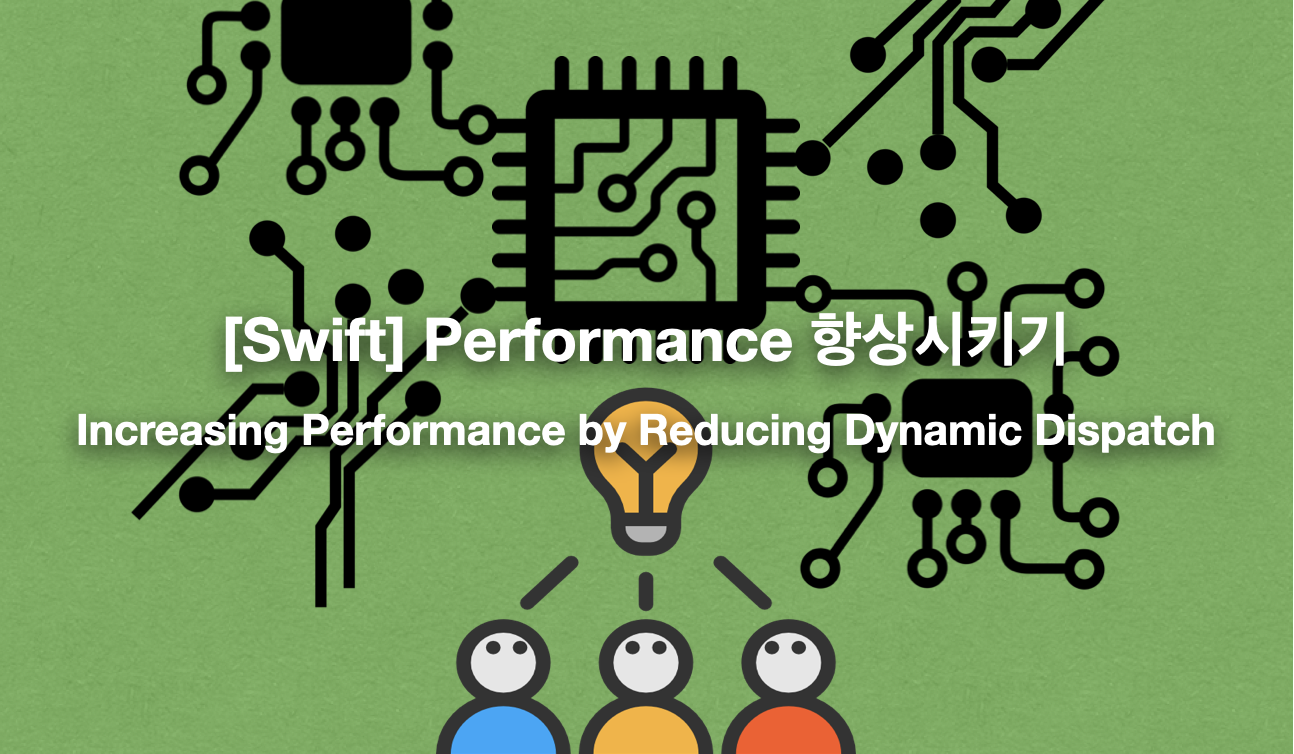
Class를 쓰게 되면 final 키워드를 붙여 상속이 안되게 해주자라는 의미로 작성했었는데
왜 그렇게 해야 좋은걸까 고민을 하기 시작했다.
Increasing Performance by Reducing Dynamic Dispatch를 읽고 정리했습니다.
Increasing Performance by Reducing Dynamic Dispatch
다른 언어와 마찬가지로 Swift도 SuperClass에 선언된 메소드와 프로퍼티 선언을 override 할 수 있다.
프로그램이 런타임에 어떤 메소드와 프로퍼티를 참조할지 결정하고,
indirect call(간접 호출), indirect access(간접 접근)을 수행해야 한다.
이것을 Dynamic Dispatch 이라 불리며,
indirect call(간접 호출) / indirect access(간접 접근)을 사용할때마다 런타임 오버헤드 비용을 증가시킨다.
성능에 민감한 코드에서는 오버헤드는 바람직하지 못하다
다이나믹함을 제거함으로써 성능을 향상시키는 3가지 방법
finalprivate모듈 최적화
하나씩 예제를 가지고 살펴보자
class ParticleModel {
var point = ( 0.0, 0.0 )
var velocity = 100.0
func updatePoint(newPoint: (Double, Double), newVelocity: Double) {
point = newPoint
velocity = newVelocity
}
func update(newP: (Double, Double), newV: Double) {
updatePoint(newP, newVelocity: newV)
}
}
var p = ParticleModel()
for i in stride(from: 0.0, through: 360, by: 1.0) {
p.update((i * sin(i), i), newV:i*1000)
}위 코드를 보면 컴파일러는 동적으로 호출한다.
- p의 update 호출
- p의 updatePoint 호출
- p의 point 튜플 속성에 접근
- p의 velocity 속성에 접근
ParticleModel의 서브 클래스들이 메소드와 프로퍼티를 오버라이딩을 할 수 있기 때문에 동적으로 호출된다.
Swift에서 동적인 호출은 메서드 테이블에서 찾고 간접 호출을 수행한다.
- 직접 호출에 비해서 느리다.
- 많은 컴파일러의 최적화를 막아 훨씬 더 많은 비용이 든다.
오버라이딩 할 필요없는 속성은 final을 사용하자!
final은 클래스의 메소드, 프로퍼티가 오버라이드 할 수 없도록 하는 키워드이다.
컴파일러가 동적인 간접 호출, 간접 접근을 생략할 수 있게한다.
// 프로퍼티와 메소드에 final
class ParticleModel {
final var point = ( x: 0.0, y: 0.0 )
final var velocity = 100.0
final func updatePoint(newPoint: (Double, Double), newVelocity: Double) {
point = newPoint
velocity = newVelocity
}
func update(newP: (Double, Double), newV: Double) {
updatePoint(newP, newVelocity: newV)
}
}
// 클래스 자체에 final
final class ParticleModel {
var point = ( x: 0.0, y: 0.0 )
var velocity = 100.0
// ...
}private 키워드를 사용하면 한 파일에서만 참조되는 final 선언임을 추론할 수 있다!
private키워드를 선언부에 작성하면 현재 파일에만 선언이 노출되도록 제한한다.- 컴파일러가 모든 잠재적인
오버라이딩 선언을 찾을 수 있도록 한다. - 오버라이딩 선언이 없으면 컴파일러는 자동으로
final키워드를 추론하고 메소드와 프로퍼티 접근에 대한간접 호출,간접 접근을 제거한다.
// 프로퍼티와 메소드에 private
class ParticleModel {
private var point = ( x: 0.0, y: 0.0 )
private var velocity = 100.0
private func updatePoint(newPoint: (Double, Double), newVelocity: Double) {
point = newPoint
velocity = newVelocity
}
func update(newP: (Double, Double), newV: Double) {
updatePoint(newP, newVelocity: newV)
}
}
// class에 private
private class ParticleModel {
var point = ( x: 0.0, y: 0.0 )
var velocity = 100.0
// ...
}internal 선언을 final로 추론할 수 있는 전체 모듈 최적화를 사용하자!
-
internal접근자(default)는 선언된 모듈 내에서만 볼 수 있다. -
Swift는 일반적으로 모듈을 구성하는 파일들을 개별적으로 컴파일하기 때문에
컴파일러는internal선언이 다른 파일에서 오버라이딩 되었는지 알 수 없다. -
전체
모듈 최적화옵션을 활성화하면 모든 모듈이 동시에 컴파일된다.
전체 모듈에 대해 컴파일러가 추론이 가능하게 되어 오버라이딩 되지 않은 internal을 final로추론할 수 있게된다.
public class ParticleModel {
var point = ( x: 0.0, y: 0.0 )
var velocity = 100.0
func updatePoint(newPoint: (Double, Double), newVelocity: Double) {
point = newPoint
velocity = newVelocity
}
public func update(newP: (Double, Double), newV: Double) {
updatePoint(newP, newVelocity: newV)
}
}
var p = ParticleModel()
for i in stride(from: 0.0, through: times, by: 1.0) {
p.update((i * sin(i), i), newV:i*1000)
}모듈 최적화 옵션을 활성화하고 이 코드를 컴파일하면,
컴파일러는 point, velocity, updatePoint를 final로 추론할 수 있다.
반면에 update는 public 접근자를 갖기 때문에 final로 추론이 안된다.
